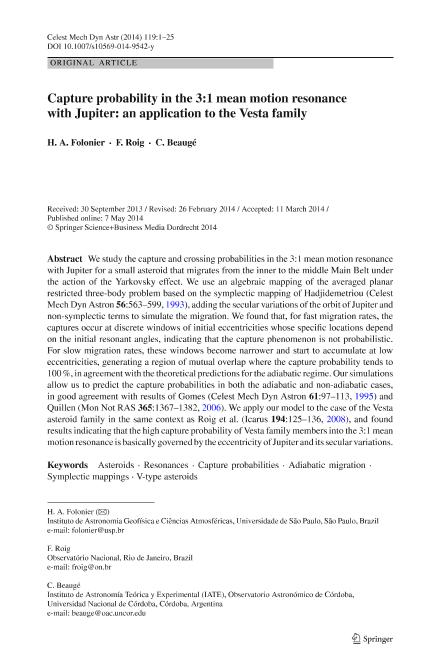Mostrar el registro sencillo del ítem
dc.contributor.author
Folonier, H.A.
dc.contributor.author
Roig, F.
dc.contributor.author
Beauge, Cristian

dc.date.available
2023-01-05T20:16:54Z
dc.date.issued
2014-05
dc.identifier.citation
Folonier, H.A.; Roig, F.; Beauge, Cristian; Capture probability in the 3:1 mean motion resonance with Jupiter: An application to the Vesta family; Springer; Celestial Mechanics & Dynamical Astronomy; 119; 1; 5-2014; 1-25
dc.identifier.issn
0923-2958
dc.identifier.uri
http://hdl.handle.net/11336/183613
dc.description.abstract
We study the capture and crossing probabilities in the 3:1 mean motion resonance with Jupiter for a small asteroid that migrates from the inner to the middle Main Belt under the action of the Yarkovsky effect. We use an algebraic mapping of the averaged planar restricted three-body problem based on the symplectic mapping of Hadjidemetriou (Celest Mech Dyn Astron 56:563-599, 1993), adding the secular variations of the orbit of Jupiter and non-symplectic terms to simulate the migration. We found that, for fast migration rates, the captures occur at discrete windows of initial eccentricities whose specific locations depend on the initial resonant angles, indicating that the capture phenomenon is not probabilistic. For slow migration rates, these windows become narrower and start to accumulate at low eccentricities, generating a region of mutual overlap where the capture probability tends to 100 %, in agreement with the theoretical predictions for the adiabatic regime. Our simulations allow us to predict the capture probabilities in both the adiabatic and non-adiabatic cases, in good agreement with results of Gomes (Celest Mech Dyn Astron 61:97-113, 1995) and Quillen (Mon Not RAS 365:1367-1382, 2006). We apply our model to the case of the Vesta asteroid family in the same context as Roig et al. (Icarus 194:125-136, 2008), and found results indicating that the high capture probability of Vesta family members into the 3:1 mean motion resonance is basically governed by the eccentricity of Jupiter and its secular variations. © 2014 Springer Science+Business Media Dordrecht.
dc.format
application/pdf
dc.language.iso
eng
dc.publisher
Springer

dc.rights
info:eu-repo/semantics/openAccess
dc.rights.uri
https://creativecommons.org/licenses/by-nc-sa/2.5/ar/
dc.subject
ADIABATIC MIGRATION
dc.subject
ASTEROIDS
dc.subject
CAPTURE PROBABILITIES
dc.subject
RESONANCES
dc.subject
SYMPLECTIC MAPPINGS
dc.subject
V-TYPE ASTEROIDS
dc.subject.classification
Astronomía

dc.subject.classification
Ciencias Físicas

dc.subject.classification
CIENCIAS NATURALES Y EXACTAS

dc.title
Capture probability in the 3:1 mean motion resonance with Jupiter: An application to the Vesta family
dc.type
info:eu-repo/semantics/article
dc.type
info:ar-repo/semantics/artículo
dc.type
info:eu-repo/semantics/publishedVersion
dc.date.updated
2022-12-06T17:26:01Z
dc.identifier.eissn
1572-9478
dc.journal.volume
119
dc.journal.number
1
dc.journal.pagination
1-25
dc.journal.pais
Alemania

dc.journal.ciudad
Berlin
dc.description.fil
Fil: Folonier, H.A.. Universidade do Sao Paulo. Instituto de Astronomia, Geofísica e Ciências Atmosféricas; Brasil
dc.description.fil
Fil: Roig, F.. Observatório Nacional, Rio de Janeiro; Brasil
dc.description.fil
Fil: Beauge, Cristian. Consejo Nacional de Investigaciones Científicas y Técnicas. Centro Científico Tecnológico Conicet - Córdoba. Instituto de Astronomía Teórica y Experimental. Universidad Nacional de Córdoba. Observatorio Astronómico de Córdoba. Instituto de Astronomía Teórica y Experimental; Argentina
dc.journal.title
Celestial Mechanics & Dynamical Astronomy

dc.relation.alternativeid
info:eu-repo/semantics/altIdentifier/url/https://link.springer.com/article/10.1007/s10569-014-9542-y
dc.relation.alternativeid
info:eu-repo/semantics/altIdentifier/doi/http://dx.doi.org/10.1007/s10569-014-9542-y
Archivos asociados
